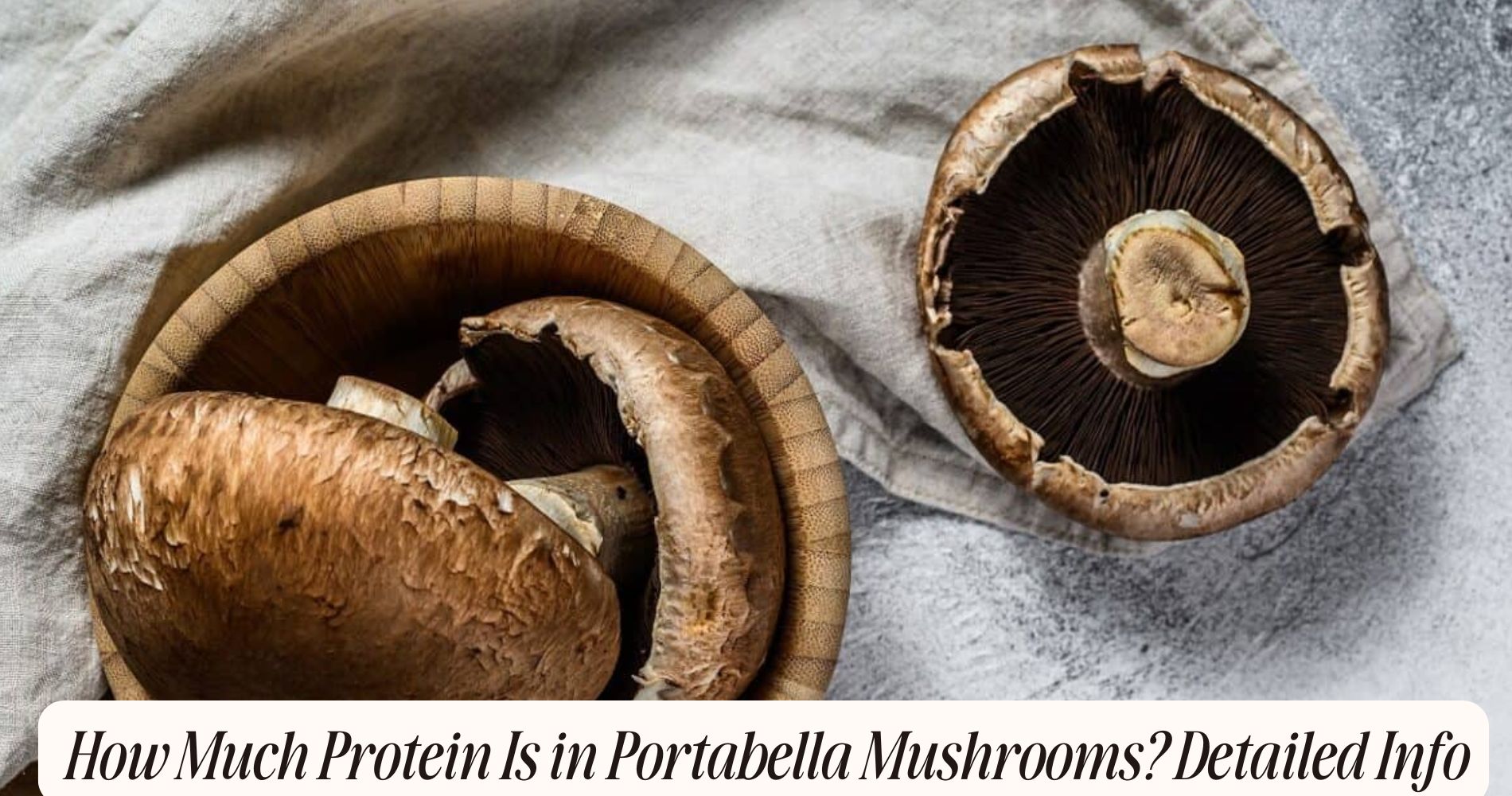
How Much Protein Is in Portabella Mushrooms? Detailed Info
How much protein in portabella mushrooms? Portabella mushrooms contain about 3 grams of protein per medium-sized mushroom, offering a healthy addition to your meals. While their protein content is modest compared to animal sources, they can still contribute to your daily intake, especially in plant-based diets. Cooking methods like grilling or sautéing can help preserve their protein while enhancing flavor. Beyond protein, portabellas are rich in antioxidants, vitamins, and fiber, supporting overall health. If you're curious about how to incorporate them into your cooking, there are plenty of tasty options to explore.
Nutritional Profile of Portabella Mushrooms
Portabella mushrooms pack a surprising nutritional punch, offering a variety of essential nutrients in a low-calorie package. These versatile fungi are rich in antioxidants, particularly ergothioneine, which can help combat oxidative stress in your body. They also contain B vitamins, such as riboflavin and niacin, which play crucial roles in energy metabolism and maintaining a healthy nervous system.
When it comes to dietary balance, incorporating portabella mushrooms can enhance your meals without adding excessive calories. They provide a modest amount of protein, which contributes to your overall protein absorption, especially when combined with other protein-rich foods. Although they aren't a complete protein source on their own, using them alongside legumes, grains, or nuts can help you achieve a more balanced diet.

Additionally, portabella mushrooms are a good source of fiber, promoting digestive health and keeping you full longer. Their naturally low sodium and fat content make them an excellent choice for anyone looking to maintain a healthy lifestyle.
Protein Content Comparison
When you compare the protein density of portabella mushrooms to other vegetables, you'll find that they offer a unique nutritional profile.
While many vegetables contain minimal protein, portabellas provide a more substantial amount, making them an excellent choice for those looking to boost their intake.
Understanding this comparison can help you appreciate the nutritional benefits these mushrooms bring to your diet.
Protein Density in Mushrooms
Mushrooms, including varieties like portabella, are often praised for their low-calorie count and unique flavors, but their protein content can vary markedly. When you look at mushroom protein density, you'll find that portabella mushrooms contain about 2.5 grams of protein per 100 grams. This is a decent amount compared to many vegetables, yet it still falls short of higher-protein foods like legumes or meat.
It's also essential to evaluate protein absorption factors when assessing mushrooms as a protein source. The protein in mushrooms mightn't be as bioavailable as that found in animal products, meaning your body may not absorb it as efficiently. Factors like cooking methods can influence the protein's digestibility; sautéing or grilling mushrooms can enhance their nutrient profile, making the protein more accessible.
Moreover, mushrooms are low in calories, making them an excellent addition for those looking to manage their weight while increasing protein intake. While they won't replace your traditional protein sources, incorporating portabella mushrooms into your meals can contribute to your overall protein consumption and provide additional health benefits.
Comparison With Other Vegetables
While portabella mushrooms offer a respectable protein content compared to many vegetables, it's beneficial to compare their nutritional profile with other plant-based options. For instance, compared to spinach, which has about 3 grams of protein per cooked cup, portabella mushrooms provide around 4 grams per cup. Broccoli also stands out, delivering about 4 grams of protein per cup when cooked.
However, the cooking techniques you use can affect both the protein content and its absorption. Cooking methods like steaming or sautéing can help break down cell walls in vegetables, making protein more accessible for your body. On the other hand, boiling might lead to some nutrient loss, which can impact overall protein intake.
When considering protein absorption, it's important to recognize that combining different plant sources can enhance this process. For example, pairing mushrooms with legumes or grains can provide a more complete amino acid profile, improving overall nutritional value.
While portabella mushrooms are a great addition to your diet, exploring various vegetables can guarantee you're getting a wider range of nutrients and optimizing your protein intake.
Nutritional Benefits Overview
Portabella mushrooms stand out not just for their unique flavor and texture, but also for their protein content, making them a nutritious choice in a balanced diet. When comparing portabella varieties to other vegetables, you'll find that they offer a higher protein content, which can be particularly beneficial for those seeking plant-based protein sources. A single medium portabella mushroom contains about 3 grams of protein, while many other vegetables provide only 1 gram or less per serving.

Incorporating these mushrooms into your meals can enhance your overall protein intake without overwhelming calories. Plus, their meaty texture makes them a versatile ingredient in various culinary uses. You can grill, roast, or sauté them, and they work wonderfully as a meat substitute in burgers or stir-fries.
While portabella mushrooms are an excellent source of protein for a vegetable, they don't quite match the protein levels found in legumes or animal products. However, they can complement these foods beautifully, creating a balanced meal rich in nutrients.
Cooking Methods and Protein Retention
When you cook portabella mushrooms, the method you choose can greatly affect their protein content.
Techniques like steaming or sautéing tend to preserve more nutrients compared to boiling, which can lead to nutrient loss.
Cooking Techniques Impact
Cooking techniques can greatly influence the protein content of portabella mushrooms, as different methods may either preserve or diminish their nutritional value.
When you use grilling techniques, for example, the high heat can quickly sear the outside of the mushroom, helping to retain moisture and protein. This method also enhances flavor without significant nutrient loss, making it a popular choice for many.
On the other hand, if you opt for sautéing methods, the outcome may vary. Sautéing mushrooms at a high temperature with a small amount of oil can retain much of their protein content. However, prolonged cooking times or excessive heat can lead to nutrient degradation.
It's crucial to strike a balance; shorter cooking times can help maintain the protein levels while still achieving that desirable texture and taste.
Ultimately, choosing the right cooking technique is key to maximizing the protein you get from portabella mushrooms.
Whether you're grilling or sautéing, keep in mind that cooking times and temperatures can make all the difference in preserving their nutritional benefits.
Nutrient Preservation Strategies
To maximize the protein retention in portabella mushrooms, it's essential to employ specific nutrient preservation strategies during preparation. Cooking methods can greatly influence nutrient retention, particularly when it comes to protein.
Steaming or sautéing these mushrooms with minimal oil is often the best approach, as these methods cook them quickly while preserving their nutritional value.
Avoid boiling, as it can lead to nutrient loss through leaching into the water. If you prefer grilling or roasting, keep the cooking time short to help maintain protein levels.
Another effective strategy is to cut the mushrooms into larger pieces, which can reduce the surface area exposed to heat and help retain more nutrients.
You might also consider using lower cooking temperatures, as high heat can degrade proteins. Additionally, incorporating portabella mushrooms into dishes rather than cooking them alone can help preserve their nutrients.
By employing these cooking methods and techniques, you can guarantee that you're enjoying the full benefits of protein and other nutrients found in portabella mushrooms.
Health Benefits of Portabella Mushrooms
Portabella mushrooms offer a range of health benefits that make them a valuable addition to any diet. They provide immune support due to their rich nutrient content, helping your body fend off infections.
Their antioxidant properties combat oxidative stress, which can damage cells and lead to chronic diseases. If you're focused on weight management, these mushrooms are low in calories yet high in fiber, promoting satiety without excess calories.

Moreover, portabella mushrooms exhibit anti-inflammatory effects that can reduce inflammation in the body, benefiting overall health. They also support digestive health through their fiber content, aiding in regular bowel movements.
For heart health, the potassium in these mushrooms helps regulate blood pressure, while their fiber can lower cholesterol levels.
Additionally, portabella mushrooms offer skin benefits, potentially improving skin health due to their vitamin D content. They may play a role in cancer prevention, thanks to their bioactive compounds.
You'll also appreciate the energy boost they provide, making them a great choice for an active lifestyle. Finally, their ability to assist in blood sugar regulation can be an important factor for those managing diabetes.
Portabella Vs. Other Mushrooms
When comparing portabella mushrooms to other varieties, it's clear that each type brings its own unique set of nutritional profiles and culinary uses.
Portabella mushrooms are known for their meaty texture, making them an excellent substitute for meat in various dishes. Their large caps can be grilled, stuffed, or used as a burger replacement, showcasing their culinary versatility.
In contrast, white button mushrooms are milder and often used in salads or as a cooking ingredient. Shiitake mushrooms, on the other hand, offer a rich umami flavor, making them popular in Asian cuisine.
While portabellas are higher in protein than white button mushrooms, they still fall short compared to shiitakes, which also contain beneficial compounds like lentinans that support immune health.
Ultimately, your choice may depend on the dish you're preparing. If you're looking for a robust, hearty addition, portabellas shine.
However, if you're after a subtler flavor or a different texture, other varieties may better suit your needs. By understanding the unique attributes of each mushroom type, you can elevate your meals with the right selection.
Plant-Based Protein Sources
Many people are increasingly turning to plant-based protein sources as a way to meet their nutritional needs while promoting a more sustainable diet. Vegan protein options are abundant, ranging from legumes and grains to nuts and seeds.
Beans, lentils, and chickpeas are excellent choices, providing essential amino acids and fiber, which contribute to overall health. Quinoa and brown rice are also great sources of plant nutrition, offering a complete protein profile when combined with legumes.
Nuts and seeds, such as almonds and chia seeds, not only supply protein but also healthy fats, making them a versatile addition to your meals. Additionally, green vegetables like spinach and broccoli contain protein too, though in smaller amounts.

Portabella mushrooms, while not as protein-dense as beans, can complement your diet with unique flavors and textures, adding variety to your plate.
Incorporating a mix of these plant-based protein sources guarantees you're not only getting enough protein but also a wide range of nutrients. Shifting to a plant-focused diet can be rewarding, offering health benefits while supporting environmental sustainability.
Incorporating Portabella Into Meals
Adding Portabella mushrooms to your meals can enhance both flavor and nutrition, making them a fantastic option for those looking to incorporate plant-based ingredients. These versatile mushrooms boast a rich, meaty texture and an earthy flavor profile, which makes them an excellent substitute for meat in various dishes.
When planning meal pairings, consider using Portabella mushrooms in pasta, stir-fries, or salads. Grilled Portabella caps can serve as a delicious burger alternative, topped with your favorite condiments and fresh veggies.
You can also slice them and sauté them with garlic and herbs for a savory side dish that complements any entrée.
Incorporating Portabella mushrooms into your meals can elevate the overall taste experience. Their umami flavor enhances soups and stews, while their ability to absorb spices allows them to blend seamlessly into various cuisines, from Italian to Asian.
Experiment with different cooking methods, like roasting or stuffing, to highlight their unique flavor profiles. With their nutritional benefits and culinary versatility, Portabella mushrooms can be a delightful addition to your diet, making meals both satisfying and healthful.
Myths About Mushroom Protein
There's a common misconception that mushrooms, including Portabella varieties, can't provide sufficient protein compared to traditional sources like meat or legumes. This myth stems from a lack of understanding about mushroom nutrition.
While it's true that mushrooms aren't as protein-dense as some other foods, they still contribute to your daily intake in a meaningful way. In fact, Portabella mushrooms contain about 3 grams of protein per 100 grams, which can be a helpful addition to a balanced diet.
Myth debunking in this area highlights that mushrooms aren't just filler; they bring valuable nutrients, including fiber, vitamins, and minerals, alongside protein.
Another prevalent protein misconception is that plant-based proteins are inferior. While mushrooms don't contain all essential amino acids like some animal proteins do, they can still play an integral role in a mixed diet.
Combining them with other protein sources—like grains or legumes—can help you achieve a complete amino acid profile.
Recommended Daily Protein Intake
Understanding your daily protein needs is essential for maintaining overall health and well-being.
You'll find that various protein sources offer different benefits, and it's important to compare them to guarantee you're meeting your nutritional requirements.
In this discussion, we'll explore how much protein you should aim for and the advantages of including diverse protein sources in your diet.
Daily Protein Needs
Typically, adults need a daily protein intake that varies based on factors like age, sex, and activity level. The general protein intake guidelines suggest that adults should aim for 46 grams per day for women and 56 grams for men.
However, if you're more active or are trying to build muscle, your daily protein requirements may increase. For example, athletes or those engaged in intense physical activities might benefit from a protein intake of 1.2 to 2.0 grams per kilogram of body weight. This means that if you weigh 70 kilograms, your protein needs could range from 84 to 140 grams daily, depending on your activity level.
It's important to take into account that individual needs can also be influenced by other factors, such as health conditions and overall dietary goals. Tracking your protein intake can help you meet your unique requirements.
Additionally, incorporating a variety of protein sources, including plant-based options like portabella mushrooms, can help you achieve a balanced diet. Always consult with a healthcare professional or a registered dietitian to tailor your protein intake to your specific needs.
Protein Sources Comparison
When comparing protein sources, it's essential to take into account both the quantity and quality of protein they provide. For instance, tofu often comes up in discussions about plant-based proteins. A typical serving of firm tofu contains around 20 grams of protein, making it a substantial option for those looking to increase their intake.
In a tofu comparison, you'll notice it's not only rich in protein but also provides essential amino acids, which are important for muscle repair and growth.

On the other hand, lentil protein offers another excellent choice for vegetarians and vegans. One cup of cooked lentils contains about 18 grams of protein, along with a wealth of fiber, vitamins, and minerals.
While lentils may have slightly less protein than tofu, they deliver a diverse range of nutrients that complement a balanced diet.
Ultimately, both tofu and lentils are fantastic protein sources, but your choice may depend on personal preferences, dietary restrictions, or specific nutritional goals.
Health Benefits Overview
Protein plays an essential role in your overall health, and knowing the recommended daily intake can help you meet your nutritional goals. For most adults, the general guideline is to consume about 46 grams for women and 56 grams for men each day. This varies based on factors like age, activity level, and health status.
Incorporating protein-rich foods into your diet, such as portabella mushrooms, can provide numerous health benefits. These mushrooms not only offer a decent amount of protein but also contain essential nutrients that support your immune system. The antioxidants and vitamins found in portabella mushrooms can help bolster your body's defenses against illness.
Additionally, adequate protein intake is vital for muscle repair, tissue growth, and maintaining a healthy metabolism. By ensuring you meet your daily protein requirements, you can enhance your overall well-being and energy levels.
Recipes Featuring Portabella Mushrooms
Portabella mushrooms are incredibly versatile and can elevate a variety of dishes with their rich, meaty flavor. One popular way to enjoy them is by making stuffed mushrooms. Simply remove the stems, mix them with breadcrumbs, garlic, cheese, and your favorite herbs, then fill the caps before baking them until golden. This dish serves as a delightful appetizer or side.
If you're looking for a hearty main course, try making mushroom burgers. Grill or pan-sear whole portabella caps and serve them on a bun with your choice of toppings, such as avocado, lettuce, and tomato. The umami flavor of the mushrooms creates a satisfying alternative to traditional meat burgers, making them a hit among both vegetarians and meat-eaters alike.
Additionally, you can slice portabella mushrooms for stir-fries, pasta dishes, or salads. Their robust texture holds up well in various cooking methods, allowing you to experiment with flavors and ingredients.
With their high protein content and numerous health benefits, incorporating portabella mushrooms into your meals not only enhances taste but also boosts nutritional value. Enjoy these recipes to discover the full potential of portabella mushrooms in your kitchen!
Frequently Asked Questions
Can Portabella Mushrooms Help With Muscle Recovery After Workouts?
Yes, portabella mushrooms can aid muscle recovery post-workout due to their nutritional profile. While not a primary protein source, they complement workout nutrition by providing vitamins and minerals that support overall recovery and health.
Do Portabella Mushrooms Contain Any Allergens?
Portabella mushrooms can contain allergens for some individuals, particularly those with mushroom allergies. Always check allergen information before consuming. If you're unsure, consult a healthcare professional to ascertain they're safe for you to eat.
Are There Any Side Effects of Consuming Portabella Mushrooms?
While portabella mushrooms offer great nutrient density and versatile culinary uses, excessive consumption might cause digestive issues for some. It's important to enjoy them in moderation to avoid potential side effects like bloating or gas.
How Do Portabella Mushrooms Affect Cholesterol Levels?
Portabella mushrooms can aid cholesterol management by providing fiber and antioxidants, which support heart health. Incorporating them into your diet offers health benefits, potentially lowering bad cholesterol levels while promoting overall well-being.
Can Portabella Mushrooms Be Part of a Ketogenic Diet?
Yes, portabella mushrooms can fit into your ketogenic diet. Their low-carb content and rich nutritional benefits, including fiber and antioxidants, make them a great choice for maintaining ketogenic compatibility while enhancing your meals.
Conclusion
Incorporating portabella mushrooms into your diet is a great way to boost your protein intake while enjoying their rich flavor and health benefits. With around 3 grams of protein per cup, they offer a satisfying addition to meals. Remember, cooking methods can affect protein retention, so consider grilling or sautéing for the best results. By understanding their nutritional profile and exploring various recipes, you can easily enhance your meals with these versatile fungi.




